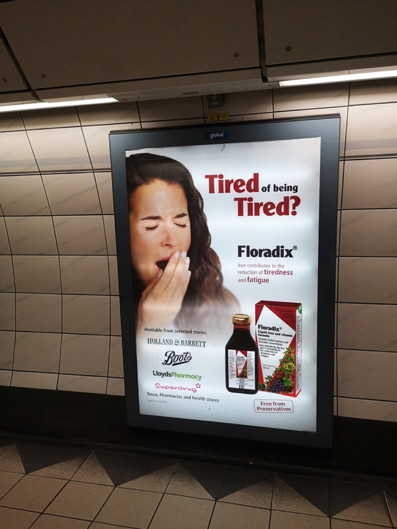
Take a good, hard look at this picture. Since sitting down to write this, I’ve already yawned 3 times. It’s only 11.32am and, in case you were wondering, I slept really well last night. I’m even half way through a coffee. But, despite all of this, I’m struggling to stifle my yawns.
Anyone who’s taken the tube in London over the last few years will be familiar with the lethargy-inducing sight of Floradix’s sleep-deprived yawning lady.
“Tired of being tired?” she asks commuters.
Well, yes, actually - we’re all feeling knackered now. But why does this picture evoke this reaction?
There are several principles from behavioural science which can help to explain.
1. We process pictures much faster than we process words…
Known as the picture superiority effect, this means that our brains process pictures in just 13 milliseconds, compared to the 400 milliseconds it takes for us to read and understand a word. As such, it doesn’t take long for an image, like the one Floradix use, to trigger a visceral reaction such as yawning.
2. …and we’re hardwired to mimic facial expressions, such as yawning.
Known as facial mimicry, this means that many people find yawning ‘contagious’ – in other words, when we see someone else yawn, we want to yawn too.
It’s been shown that those with higher levels of empathy experience more yawn contagion, and it follows that those with low empathy, such as those with Autism Spectrum Disorder, are less likely to catch yawns. As you might expect, some studies also find that women are more likely to catch yawns than men.
3. After yawning, we feel more tired…
Seeing a picture of someone yawning, therefore, makes us yawn too. “I yawn, therefore I’m tired – and so maybe I should try an iron supplement.” Known as embodied cognition, this is where our behaviour (such as a yawn) influences our perception (such as feeling tired).
4. …and this closes the empathy gap
This is what makes the yawning Floradix woman such as powerful nudge. She closes the gap between our current selves (alert and perky) with our future selves (tired and in need of an iron supplement). In other words, she closes the empathy gap, the mental abyss between our current emotional state and our future one.
At Cowry, there are many ways in which we help our clients to close the empathy gap to improve their customer and employee experience.
Whilst we might not want to nudge anyone to feel tired, there are creative ways in which we can use imagery to promote certain behaviours – whether that’s filling out a form, saving more money for a happy retirement, or empathising with vulnerable customers.